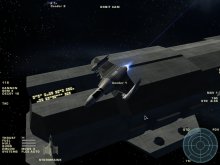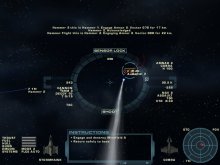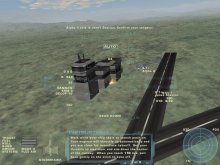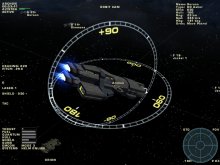 Home
News, and the latest updates.
Archives
Stories from the past...
Submit News
Got a item of interest? Here's the place to go.
Feedback
Your opinion always counts on how we can make GameSurge
even better.
Mailbag
Comments on our features, by you, the viewers. | 
Hardware
Tweaks, reviews and a handy driver index highlight our newest section
Reviews
Looking to buy one of the hottest games? We have it covered.
Previews
Get a advanced look at the games of tomorrow.
Interviews
Find out more about the people behind your favorite game.
Strategy
Need Help? We have a very large selection of walkthroughs now up.
Gallery
A special section featuring the best in artwork and
images. |

Editorials
The written word, by staff and viewers.
Game Guy
A bi-monthly column contributed by Mark H Walker, an independant writer in the Gaming community.
Gallery
Pictures from around the web.
Hosting
Our current hosting plans and features.
Site Information
Who we are, what we do, our policies and job positions.
|


PlayStation
The Sony PlayStation, and beyond...
Nintendo 64
Currently Down.
Dreamcast
The Dreamcast resource, and more. Home of the DC Technical pages. |
|
Starshatter Review
System Requirements:
Win98+
Pentium II 400 MHz (P3 700 Rec)
128MB RAM (256MB rec)
100MB Disk Space
3D Accelerated card (DX7 +) // Software Rendering also available
Mouse & Keyboard
CD Rom
Joystick or Gamepad Optional.
At a time where the big gaming hits are in RPG and FPS games; Starshatter
brings in a fresh addition into the industry, and in particular the space
sim genre.
 The early stages of the game are similar to the standard formula of
planetary and space combat with scripted missions with dogfights and
patrol/escort/strike assignments. However, Starshatter also combines elements
of a more complex flight sim, with far more controls and commands than
a game such as Wing Commander (for those who have been around long enough
to remember those days.)
The early stages of the game are similar to the standard formula of
planetary and space combat with scripted missions with dogfights and
patrol/escort/strike assignments. However, Starshatter also combines elements
of a more complex flight sim, with far more controls and commands than
a game such as Wing Commander (for those who have been around long enough
to remember those days.)
Starshatter aims to expand on the typical fighter pilot plot by allowing
players to develop along with the storyline. Promotions in the game allow
the player to develop as they would in reality, with the ultimate role
of commanding a fleet of ships and fighters. This development in the game
adds a real time strategy component where the game can be played on a larger tactical
scale. This is similar to Homeworld, where entire fleets of ships
can be deployed and directed in missions such as blockade, starbase assualt and fighter ops.
For those who like to play with the more technical aspects of the game,
Starshatter allows for mods to be easily created and installed, so that
customised ships and weapons can easily be designed. The mission editor
can create a vast range of missions, and even voice recorded briefings are possible.
A mission can be set up step-by-step, using ships and weapons
already available, or taken from any mod that has been activated. The process
for creating a mission is fairly detailed, and includes the basics such
as adding mission elements and events, as well as complex aspects such
as setting a chain of command for included ships to follow. The manual
is fairly comprehensive and the process is set up in a user-friendly interface.
 There is also a diverse range of options to customise and modify the
game. For example you can choose to use Zero-Drag Newtonian physics, which
is similar to real world aerodynamics in an atmosphere, or you can choose
an arcade style model, which will just fly the ship in the direction it
is pointing at. You can also modify the HUD so that the basic interface
is available for the arcade style gameplay, or use a detailed HUD for a
flight sim-playing environment. There is also a diverse range of options to customise and modify the
game. For example you can choose to use Zero-Drag Newtonian physics, which
is similar to real world aerodynamics in an atmosphere, or you can choose
an arcade style model, which will just fly the ship in the direction it
is pointing at. You can also modify the HUD so that the basic interface
is available for the arcade style gameplay, or use a detailed HUD for a
flight sim-playing environment.
The playing interface caters for a large range of options, including
keyboard, mouse and joystick. It is possible to toggle between using the
mouse for flight steering along with the keyboard buttons for control,
or to select an option to temporarily disable mouse steering in order to use the
pointer to click and select options on the HUD. While you will probably
need to print out a list of keys to make full tactical advantage in the
game, the basics of the controls are easy enough to use to get a decent
gaming experience. There is also a tutorial available with the basics of
the game to get things kick started.
 The fighter missions of Starshatter are a bit of a cross between a simulator
and a shooter. Various aspects of a mission are modelled more to reflect
more complex and detailed controls and elements. The gameplay itself quite
simple with early patrol or assault missions that allow you to follow scripted
nav points and generally wipe out anything hostile in your way. The fighter missions of Starshatter are a bit of a cross between a simulator
and a shooter. Various aspects of a mission are modelled more to reflect
more complex and detailed controls and elements. The gameplay itself quite
simple with early patrol or assault missions that allow you to follow scripted
nav points and generally wipe out anything hostile in your way.
Unfortunately there are aspects of the game design that are quite frustrating.
A lack of shields on a fighter means that all damage is permanent until
the mission is over, and without any way to replenish the hull strength;
this becomes an extremely annoying aspect of the game. Most people can
imagine what it would be like to play a first person shooter and have to
follow a large stretch with only limited health and no powerups. I have
found dogfights against multiple opponents incredibly tough, since there
is no real advantage over the AI units in combat. Missiles are also overly
powerful and tend to be unbalanced due to the fact that they will nearly
take out an enemy from long range, while close range combat with multiple
opponents tends to be suicidal. This can dampen the gaming experience due to the
need to be extremely careful and rather irritating deaths.
One addition
to Starshatter that helps alleviate this issue is the use of an AI wingman
or reserve ships that can help to turn the balance in combat.
The gameplay speed is also very slow, and while automatic flights for
large (several minute) traverses are handy, I have spent 30-60 seconds
in pursuit of a target only making a small headway with very little eye
candy in between.
 Later in the game when you gain sufficient rank you will be able to
control capital ships. While the first person perspective is available,
it is generally easiest to use the third person perspective to select and
direct ships. These units will respond to directions similarly to controlling
units in a RTS game. Capital ship combat includes weaponry such as torpedoes,
lasers and point defence systems – an upgrade from the cannons and missiles
from fighter combat. The more strategic elements of Starshatter come into
play here when deciding how to coordinate large scale attacks with multiple
units and attack vectors. Later in the game when you gain sufficient rank you will be able to
control capital ships. While the first person perspective is available,
it is generally easiest to use the third person perspective to select and
direct ships. These units will respond to directions similarly to controlling
units in a RTS game. Capital ship combat includes weaponry such as torpedoes,
lasers and point defence systems – an upgrade from the cannons and missiles
from fighter combat. The more strategic elements of Starshatter come into
play here when deciding how to coordinate large scale attacks with multiple
units and attack vectors.
The graphics in Starshatter are fairly simple – the ships look respectable
but not incredibly high tech. Unfortunately, very little has been put into
supporting environmental details, where planet surfaces are often barren except for landscapes and targets.
Space combat is comparatively bare, maybe including a planet in the background.
Similarly, the sound effects and music are a standard compliment to
the game – they achieve their purpose without offering anything groundbreaking.
Overall Starshatter provides an interesting addition to an almost non-existent
genre, as well as a refreshing change to the current games in the market. While it is far from flashy, it still
holds certain entertainment value from the innovative game design from direct combat to larger scale
strategic fighting. If these aspects were developed further with some of
the flaws removed, Starshatter could have greater potential in the future.
Final score: 68%
Reviewed by Falcon :falcon@gamesurge.com
>> Back to reviews index
|
 |
|
|
Zalman: ZM-DS4F Headphones
|
An affordable, ultra-portable headphone set.
 more more
|
|
